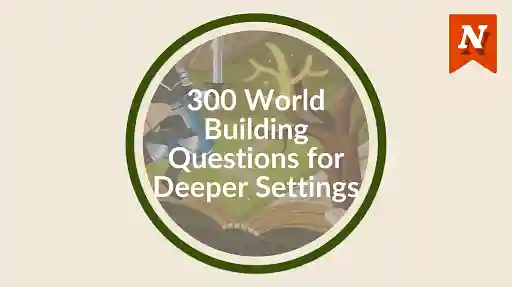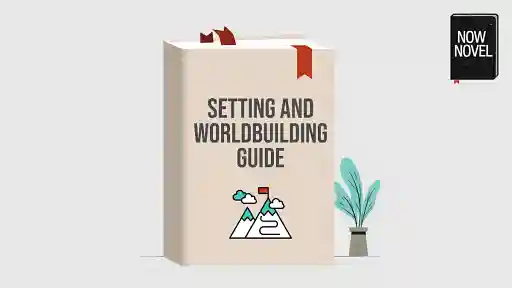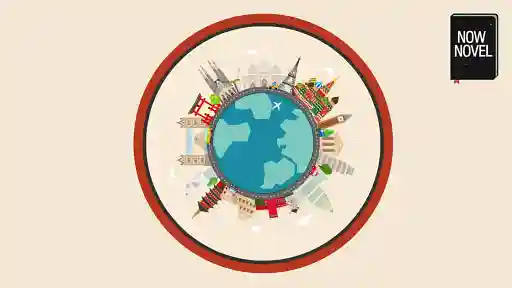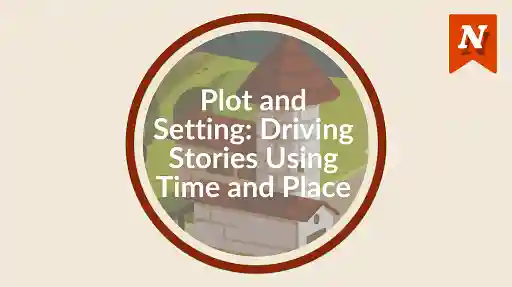When you think of vividly constructed fantasy worlds, some famous names may immediately jump to mind: Middle Earth, Avalon, Discworld, Earthsea, Narnia, Westeros, Pern. Tolkien even constructed multiple complex languages while worldbuilding Middle Earth!
But rest assured: creating a fantasy world doesn’t always require such extreme worldbuilding to be a success — in fact, less is often more.
Here’s how to create a fantasy world in 7 steps.
1. Start with a unique story premise
Any fantasy novel (or even RPG) is first and foremost a story — not a guide to a made-up world. Before you get carried away with worldbuilding, make sure you have a strong idea for your story’s central conflict and characters.
The more unique your story premise is, the better — and that’s where your world comes into play. A familiar trope can become fresh and original in a new setting. For example, Kameron Hurley’s The Stars are Legion follows members of a dying civilization as they travel through space to find a new home — but, in a unique and interesting twist, the ship they are travelling on is itself a living organism.
To find your twist, draw inspiration from past civilizations and existing mythology, mixing and matching elements to create a fantasy world unlike any other. In The Shadowhunter Chronicles by Cassandra Clare, the fresh take is that all stories (of vampires, werewolves, demons, etc.) are true.
Here are some more examples of unique premises in fantasy literature:
- The Hundred Thousand Kingdoms by N.K. Jemisin: Instead of humans being at the mercy of gods, the gods have been enslaved by humans and forced to do their will!
- Six of Crows by Leigh Bardugo: A group of misfits join forces to pull off a heist — using their unique magical abilities that also make them age slower.
- Codex Alera series by Jim Butcher: Contrary to being the “chosen one,” the protagonist Tavi is the only person in the world who’s not able to do magic.
Once you’ve established your premise, you can start fine-tuning the details of your world, either in a notebook or in a dedicated planning app. Let’s begin with the geography.
2. Define the geography of your world
The first thing to decide is whether your story takes place in a modified real world (“low fantasy”) or a completely fictional universe (“high fantasy”).
Low fantasy
The advantage of a real-world setting is that it’s more relatable for readers. Especially in middle grade and YA fantasy, the protagonist often starts the story oblivious to the hidden fantasy world to which they will soon belong. As they learn to navigate their new lives, the likes of Bella Swan, Percy Jackson, and Harry Potter all give us a gentle segue into their respective worlds.
When choosing a real-life backdrop for your story, ask yourself these questions:
- Is the story set in the past, present, or future?
- Are any natural or man-made landmarks important to the fantasy beings in the world?
- Do the fantasy beings live in their own settlements or among ordinary humans?
High fantasy
On the other hand, high fantasy offers greater opportunities for creativity, since there are no limits to what’s possible. When creating this kind of alternate world, consider the following factors that might have a bearing on your plot:
- What is the climate like? How does this vary between regions?
- What is the terrain like? How easy is it to traverse?
- Is there a risk of natural disasters?
- Are there any natural wonders?
- Where are the major settlements and where do they get their food and water from?
Tip: The setting can have a major impact on your characters and story. A harsh climate presents further obstacles for the protagonist to overcome and creates a gloomy atmosphere. On the other hand, beautiful scenery can be uplifting or provide a stark contrast to a less-than-idyllic society.
Some authors create a map of their world to show readers how all the important places fit together. For example, there is a map of “A Part of the Shire” between the prologue and chapter 1 in The Lord of the Rings.
However, even if you don’t publish your map, you might find it helpful to sketch one for your own reference; you can make sure all your settlements are near water and describe the relative positions of locations more easily.
3. Create the inhabitants
The next step is to populate your world (or the fantasy part of the real world) with animals and plants. Start with any human inhabitants:
- Are the humans in your world the same as us or have they evolved?
- Do any or all humans possess magical powers?
- Where do they live?
- How do they interact with their environment?
Next, expand your worldbuilding to the other species in your world:
- What species live in the world?
- How intelligent are they?
- Where do they live and how are they adapted to their environment?
- What does each species look, sound, smell, and feel like?
- What do they eat?
- Are there any creatures that eat them?
- How does each species reproduce and how long is their life cycle?
- What are their strengths and weaknesses as a species?
- How do the different species coexist?
Tip: “Existing” mythical creatures have certain defining characteristics which you should adhere to to avoid alienating readers. Elves must have long life expectancies, goblins must be small, and ogres must be stupid. Be sure to research what is non-negotiable across myths and legends and what is left to the author’s discretion.
You can also spare a few minutes to think about the plants that inhabit your world — but don’t waste time on anything that has no bearing on your story (see step 7)! Only think deeply about flora and fauna that serve some sort of narrative purpose — even if it’s just humor. The Golden Disagreeable and Nanny Ogg apples in Terry Pratchett’s Discworld are just there to make readers laugh by playing on the real apple varieties Golden Delicious and Granny Smith, for instance.
4. Construct societal frameworks
Now that you have the skeleton of your world, it’s time to flesh it out. To do this, for steps 4 to 5, we’ll turn to the humanities and social sciences that will make your world feel lived-in and real. Note that the order in which you tackle them will of course depend on your inspiration, creative process, and the needs of your story itself. So feel free to skip ahead and come back to the earlier categories later on.
Politics
There are a lot of political systems out there, but fantasy writers tend to choose the same few. Monarchies are popular — you see them in The Lord of the Rings, A Song of Ice and Fire, and Discworld. A meritocracy is another common choice — in Sky’s End by Marc J. Gregson, individuals can rise through the ranks in any of the twelve trades. On the other hand, it’s rare to see a republic in fantasy stories, although Adrian Tchaikovsky proves that it’s possible with Denland in Guns of the Dawn.
You don’t necessarily need to know the technical term for your political system in order to craft it effectively. All you really need to figure out are the answers to these questions:
- How is the land divided into kingdoms or territories?
- How are the rulers of each land chosen?
- Who are the current leaders and how long have they been in charge?
- What rights do citizens have?
- What are the most important laws?
- How are laws enforced?
- How do different social groups view the governing powers?
The answers to these questions not only deepen your connection to your world, but can also inspire secondary conflicts and obstacles for your protagonist to face. Perhaps they need to cross a closed border or navigate civil unrest.
Economics
Again, you don’t need an economics degree to set up a convincing fantasy economy. You can get away with only answering basic economic questions such as:
- What currencies are used in your world?
- What are the most common industries and jobs?
- How big is the difference in income between the richest and poorest citizens?
- Is there a black market? What can you buy there?
- What are the main exports and imports, if any?
Whether explicitly or implicitly, your world’s economic framework will impact your characters and plot. While Kvothe’s poverty drives almost all of his actions in Patrick Rothfuss’ The Name of the Wind, economics plays a smaller role in Harry Potter — but Griphook’s typical goblin attitude towards gold still presents a significant challenge in the final book. (Harry has to agree to give him the Sword of Gryffindor in exchange for helping him and his friends break into Gringotts, leaving them without a weapon that can kill horcruxes.)
Culture
There are so many different cultures in the real world, and even more possibilities in fiction. In A Song of Ice and Fire by George R.R. Martin, pregnant khaleesi eat a raw stallion's heart to ensure their baby will be strong. In Robert Jordan’s The Wheel of Time, Aiel follow an unwritten code of honor: if you touch an enemy in battle without harming them, they must serve you peacefully for a year and a day. You’re limited only by your imagination!
Here are some starting questions to prompt your cultural worldbuilding:
- What religions, if any, exist in your world? Is there evidence for or against these beliefs?
- Do different groups in society have different languages, religions, or cultural practices?
- What are standard and luxury foods?
- Do people get married? If so, is it for love?
- What do kids and adults do for fun?
- How would a model citizen behave?
- What is taboo in society?
- What happens to people who don’t adhere to cultural norms?
Since you won’t be able to describe everything about a society’s culture, focus on the practices that will affect the characters’ personalities and actions. For example, child labor will make teens old before their time and the threat of violent repercussions will raise the stakes when the protagonist breaks a taboo.
Magic and technology
There are many different kinds of magic and several ways to wield it. In Harry Potter, wizards cast spells with wands; in Codex Alera, Alerans gain powers by bonding with elemental spirits; and in Earthsea by Ursula K. Le Guin, magic is controlled by an ancient language called Old Speech.
To construct your magic system, ask yourself these questions:
- Who can use magic?
- How do they use magic? (Wands, incantations, gestures, etc.)
- What is the cost of using magic?
- What can magic do?
- What can’t it do?
- Where does magic come from?
- Can you see, feel, or measure magic?
- Is magic taught? If so, how and to whom?
- How is the use of magic regulated?
- How do people use magic in their daily lives?
- How does society view magic and magic users?
Don’t forget to consider the role of technology:
- How much of our technology exists in the world?
- What other technology exists?
- How do magic and technology interact?
- How do they impact transportation, communication, weaponry, and medicine?
And if your fantasy story is set in the real world, you’ll also need to think about the interactions between the fantastical and the ordinary. Humans often remain oblivious to the existence of magic and the dangers it poses (think back to our examples of Twilight, Percy Jackson, and Harry Potter). However, in Leigh Bardugo’s Grishaverse, non-magical humans are aware and distrustful of the Grisha’s magical abilities.
Here are some questions to ponder:
- Do regular humans know magic exists?
- If yes, what is their attitude toward magic?
- If no, how do magic users hide their existence?
- What attitude do magical people have toward humans?
- How much contact is there between these parallel societies?
- Are humans threatened by the conflict in the fantasy world? Do they realize this?
For even more worldbuilding questions to inspire greater depth, check out Reedsy’s Ultimate Worldbuilding Template.
5. Develop your world’s lore
By now, you should be able to picture everyday life in your fantasy world — but one thing is missing from your knowledge base: its history.
You don’t need to know everything that has ever happened. But you do need a basic understanding of all major wars, catastrophes, religious schisms, political rulings, magical events etc. that have shaped society today.
In C.S. Lewis’ The Lion, the Witch, and the Wardrobe, an ancient prophecy directly impacts how the characters in Narnia behave. It has been foretold that the witch’s reign will end when two sons of Adam and two daughters of Eve sit on the four thrones at Cair Paravel — so the White Witch fearfully tries to kill the four Pevensie children, while the oppressed animals try to assist them.
It’s worth noting that historical records don’t have to be complete. Just as we don’t know who Jack the Ripper was or what happened to Amelia Earhart, it’s totally fine to incorporate mysteries into your history — especially if they affect the characters in modern times.
6. Check for consistency
Congratulations! You’ve almost finished creating your world, but you’ve yet to complete the most important step: checking for consistency.
That’s the joy of writing fantasy: your fantasy world can be as unrealistic as you like. But it comes with one caveat: all the details have to be believable within the scope of your story. You must define the rules and limitations of physics, technology, and magic very clearly and then never break them.
Brandon Sanderson’s Allomancy in Mistborn is praised as a consistent and transparent magic system. The workings and limitations are well-defined: Allomancers can ingest and burn metals to gain temporary powers, but must ingest more to continue to use the power once a metal has been used up.
When it comes to politics and cultural values, there’s less pressure to be consistent — after all, real people believe contradictory things. However, any inconsistencies should ideally be deliberate, perhaps as a critique of society.
In Ursula Le Guin’s The Dispossessed, there is a deliberate contradiction between the claims that the planet Anarres has no laws or government and the reality of social pressure and punishment through social exclusion.
Here are a few techniques to help you work out whether your worldbuilding is internally consistent:
Fact finder
Highlight every fact about your world, then read them all consecutively. Do any of the facts contradict each other or not make sense together?
“Why don’t they just …?”
Think of a problem someone in your world might face. Ask yourself, “Why don’t they just use magic to solve it?” Whatever your answer, make sure it’s explicitly explained when you set out your magic system!
“What if …?”
Come up with a series of edge-case scenarios and test whether your established system can produce an answer. Ask questions such as:
-
What if someone tries to use magic for 24 hours straight?
-
What if two people try to cast directly opposing spells at the exact same time?
-
What if someone is drunk while trying to perform magic?
-
What if someone loses their memory? Can they still perform magic?
-
What if someone tries to cast a combat spell on themselves?
If you don’t know the answer, make one up and add it to your notes.
Ask a friend
Once you’ve checked for consistency yourself, it’s always worth having a friend, partner, or acquaintance read your notes for a sense check. Sometimes it’s easier for an outsider to spot plot holes!
7. Put most of your notes aside
The final step before you’re ready to start writing is to whittle your notes down, big time. Remember: your fantasy world exists as the backdrop for a story, not as the subject of an imaginary textbook. Too much information will at best overwhelm and at worst bore your reader.
American Fantasy author Scott Lynch sums it up nicely:
The real question in worldbuilding is not how much can I dump on the page, but how much can I get away with not actually telling people?
The answer is quite a lot. You only need to include worldbuilding details that serve one of two purposes:
Help the reader understand the plot
While geography, history, and culture intricately shape the characters and events of your story, you should still only give as much contextual information as readers need to understand how the world influences the plot.
In the Harry Potter series, J.K. Rowling explains the rules of the popular wizarding sport Quidditch and references a World Cup final in 1473, so we can infer that it’s a very old sport. We don’t need to know anything else to appreciate the importance of Quidditch to the wizarding population; that it was first played in the 11th Century and the Golden Snitch used to be a live animal called a Snidget is irrelevant. (But for super fans who are interested in deeper worldbuilding, Rowling has published shorter standalone books such as Quidditch Through the Ages — something you should probably only consider once you have a decent following.)
Bonus tip: Introduce new concepts to your reader by comparing them to familiar ones. After Wood explains the function of the Quaffle in Quidditch, Harry says, “So — that’s sort of like basketball on broomsticks with six hoops, isn’t it?” This gives the reader an image that is easy to visualize.
Immerse the reader in everyday life
Paragraphs of historical background are never a good idea — but some minor details that aren’t strictly necessary can draw the reader in. Forget about the big picture and focus on a few mundane aspects of everyday life that differ from your readers’ routines. These will help readers imagine what it’s like to live in your world and empathize with your characters.
In A Song of Fire and Ice, the characters eat meals off “trenchers” — stale pieces of bread which can either be eaten with the meal or given to the poor as alms. Although ordinary to the characters, it’s a novel practice to most readers and opens a window into Martin’s world when it isn’t action-packed.
Even though only a small percentage of what you know about your world will make it into your story directly, it’s important to spend time creating your fantasy world, as it helps you write with authenticity and authority. Plus, if your book takes off, you’ll need to know the answers to all these questions when fans inevitably start asking them!












(Sorry about my profile pic, I don't use this account often) This article, and this site in general, has been a massive help to my writing and is a great resource! Keep up the good work :)
Age Of The Geeks - About 8 years ago
Hi there, thank you! I'm glad to hear that. Will do. All the best for your writing.
Bridget At Now Novel - About 8 years ago
This was very helpful to me. Thank you! I was wondering thou, in the world I am creating I am trying to figure out distance from one place to another. I have had little success on where to look for ideas. Any suggestions would be greatly appreciated! Thank You.
Robert Decker - About 8 years ago
It's a pleasure, Robert. My apologies for the slower response, comments on our older posts don't always trigger notifications for some reason. Have you tried creating a rough sketch of a map of your world? You could create it to a specific scale (e.g. 1 centimeter in your drawing = X number of miles). That way you'd have something to refer back to showing the lay of the land in your invented world. I hope that helps!
Bridget At Now Novel - Over 7 years ago
Glad I discovered this site as of right now! I've had an idea i've admittedly been slacking on. I have the overarching plot (though it might need expanding), vague character ideas, vague society development, and the magic in the world is what i feel needs most development. It's the entire lynchpin/key of the entire setting, and i'd rather figure it out first rather than start early and then have to backtrack and reedit everything if something later contradicts something written earlier.
Tchernobog - Over 7 years ago
That sounds like a smart approach, Tchernobog. Good luck with it!
Bridget At Now Novel - Over 7 years ago
(Sorry for my profile I'm to lazy to change it–) Thanks so much for this, even tho it's a few years old, seems like the thing I've been looking for to get started! :D
Lazy Pash - Over 5 years ago
It's a pleasure, Pash! Thank you for reading our blog. I hope you get started :)
Jordan At Now Novel - Over 5 years ago
Hello! I really like this article, and it really helps me with my writing, but it doesn't solve my problem. Are there any articles you'd recommend for building a fantasy world with magic, etc. (With shops and familiars)
— - Almost 5 years ago
Hi there, thank you for your feedback. I'm sorry it didn't solve all your current worldbuilding challenges. We don't have anything specifically on shops and familiars, but you can find other worldbuilding articles here. What about writing shops and familiars (by familiars I imagine you mean animal/other companions?) are you struggling with? Thanks for reading our articles.
Jordan - Almost 5 years ago
I know a good way to world build if you have Minecraft you can create a new world and build the things you want to ad In
Air - Almost 5 years ago
Hi Air, thank you for sharing your thoughts. Minecraft would perhaps take a very long time to build a fantasy world for a story block by block :) It's amazing what people have built in it, though.
Jordan - Almost 5 years ago
I have to write a story for my English academy, and this homework is for 3 weeks... But I found this article and it helps a lot! I'd better go now and build an outline based on this article^^
I Go To Chungdahm In Korea - Over 4 years ago
Your English seems excellent already! Thank you for reading our blog, good luck with your homework, too.
Jordan - Over 4 years ago
thank you so much I have to make a mythological story this really helped 10/10
Aa - Over 4 years ago
It's a pleasure, Aa. Good luck with your mythological story and thanks for reading our blog!
Jordan - Over 4 years ago
I have a book coming up. It's my debut to writing and this blog was pretty helpful in giving me the proper base for world-building. Thank you, blogger.
Aaron - Over 4 years ago
Hi Aaron, that's great to hear! I hope you've enjoyed writing it and that it's a success. Thanks for reading our blog.
Jordan - Over 4 years ago
This has helped get a straight forward plan built up in developing my world. I have been struggling for three years as I am a self taught writer. I will be using this site for years to come. Thank you for this resource.
Vallir'd - Over 4 years ago
Hi Vallir'd, that's wonderful to hear, I'm glad we could help. Thank you for reading our blog and best of luck with your WIP. We have a webinar on worldbuilding for subscribers coming up this Wednesday (15/09) if you're interested, too.
Jordan - Over 4 years ago
I am writing a fantasy series and the main species in the world it is based it are the Elves, Dwarves, Werewolves, Orcs and Undead. I know these have been used in so many other books and movies though, so should i still use them?
Sillysoj (Not My Real Name) - Almost 4 years ago
Hi there, thank you for your question. It depends, each of these types in fantasy lore typically inhabits a different sort of place, so do you envisage your world being large enough to contain all types? Of course some authors (Pratchett comes to mind) also satirize fantasy tropes and might blend elves and other types without explaining their co-existence very extensively. The main thing I'd suggest is to make your version of these types. Elves with pointy ears and green caps, for example, are so familiar. What hasn't an elf been or done? So by all means use them, yet also if possible avoid using them in a way that reads as a cut and paste of exactly how they've been envisioned elsewhere - make it your own. I hope this helps.
Jordan - Almost 4 years ago
i am so excited to even be making this happen!
Jordan - About 3 years ago
Hi Jordan, from one Jordan to another I'm glad you're excited to work on your story! Good luck with it :)
Jordan - About 3 years ago
Hello i am creating a beautiful fantasy world but i wish to know what elements can i focus on to build this world for Its appearance to the reader. I am trying to imagine it but i feel like i need more than plants trees flowers birds what more stuff can i add. Thanks
Darawish - Almost 3 years ago
Hi Darawish, that sounds a great start. In addition to fauna and flora, animals and plant life, you could think about: Geography and geology: Are there multiple continents, or is there one supercontinent? Where are there mountains, valleys, coastlines, deserts? Or is there a type of biome completely unlike anything we have on earth due to magic or other mysterious elements? Culture and society: Is there a single type of governance (e.g. monarchy) or multiple, like there are on Earth today? Is there a dominant culture or are there many different cultures? How has place shaped cultures? (For example, maybe a coastal region has more metaphors and culture to do with water, the sea, etc.). Think about that relation between place, habitation, language for even more layers. If you'd like further ideas, please see our complete guide to fantasy here.
Jordan - Almost 3 years ago
Hello. I wanted to say that this article helped me so much! I've been struggling the past few months to make a believable fantasy world, and then I stumbled upon this amazing website! Also, do you have any other articles going into more detail about the whole process of world building? If so, I would like to read it. Thanks.
Jylie - About 2 years ago
Hello Jylie, That's so wonderful to hear! We have a lot of posts on this subject that should help you to build your fictional world. Have a look at our comprehensive guide here: https://www.nownovel.com/blog/story-setting-worldbuilding/ This might also be useful: https://www.nownovel.com/blog/world-building-questions/ And: https://www.nownovel.com/blog/world-building-questions-natural-environment/ This might be especially helpful too: https://www.nownovel.com/blog/world-building-create-civilization/ Thanks for reading the blog, and all the best for building your fantasy world!
Arja Salafranca - About 2 years ago